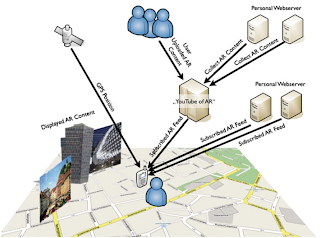Today, I looked at a research paper from 1994 entitled A Taxonomy of Mixed Reality Visual Displays. This research was one of the earliest attempts at trying to classify the newly developing (at the time) field of augmented reality. The beginning pages of this (very long) paper focus on a continuum of "virtuality", in which the researchers distinguish between a reality that is simply augmented with virtual objects (augmented reality) and a virtual world that is supplemented with the real world (augmented virtuality), with the two extremes being the physical world and a purely virtual world as outlined by the image below.
(image from the paper)
The paper then goes on at some length about the variations of augmented reality and augmented virtuality, comparing graphics-based content and video-based content, talking about technical limitations in reproduction fidelity, and some other topics. The most interesting takeaway from all of that discussion is just seeing how far the field has come in eighteen years of research and development. One topic that is still relevant to today's AR research is the idea of EWK, or Extent of World Knowledge. Some systems will need to know exactly what the world they're working with is like, so that the virtual content can interact correctly with the real world, while some systems (such as Group Graffiti!) have no need for that information. The continuum for EWK, as decided on by the researchers, is shown below.
(image from the paper)
I feel like this paper, while not really exploring new ground as far as research and development, was an essential first step for the field of augmented reality. It's also a fitting end to my blog posts about this topic, as it looks back on two action-packed decades in a comforting and nostalgic light. The end.
Thanks and gig 'em!
Kishino, Fumio; Milgram, Paul. 1994. "A Taxonomy of Mixed Reality Visual Displays". IEICE Transactions on Information Systems. Toronto, Ontario, Canada.
URL: http://www.eecs.ucf.edu/~cwingrav/teaching/ids6713_sprg2010/assets/Milgram_IEICE_1994.pdf














